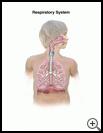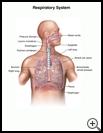
Lung Scan
________________________________________________________________________
KEY POINTS
- A lung scan is a test that uses a radioactive tracer and a scanner to see how well blood flows through the heart and lung blood vessels, and air flows through the lungs. It is your child’s healthcare provider diagnose lung problems or some heart problems.
- Ask your provider how long it will take to recover and how to take care of your child at home.
- Make sure you know what symptoms or problems you should watch for and what to do if your child has them.
________________________________________________________________________
What is a lung scan?
A lung scan is a test to look at your child’s lungs using a chemical called a radioactive tracer and a scanner. A lung scan may also be called a V-Q scan, a ventilation scan, or a perfusion scan. It helps your child’s healthcare provider see how well blood flows through the heart and lung blood vessels, and air flows through the lungs.
When is it used?
A lung scan may be done to:
- Diagnose or find a blood clot in the blood vessels in your child’s lung
- Find out if your child has lung damage from cystic fibrosis or asthma
- Check heart or lung problems that your child was born with or see how well treatment is working
How do I prepare my child for this procedure?
- Your child may or may not need to take regular medicines the day of the procedure. Tell the healthcare provider about all medicines and supplements your child takes. Some products may increase your child’s risk of side effects. Ask the healthcare provider if your child needs to avoid taking any medicine or supplements before the procedure. If your child uses inhalers, ask before your child uses them.
- Tell your child’s healthcare provider if your child has any food, medicine, or other allergies such as latex.
- Tell your child’s healthcare provider if your older child is or may be pregnant or is breastfeeding.
- Follow any instructions your child’s healthcare provider may give you.
- Ask any questions you have before the procedure. You should understand what the healthcare provider is going to do. You have the right to make decisions about your child’s care and to give permission for any tests or procedures.
What happens during the procedure?
There are 2 types of lung scans. Both may be done on the same day, usually one right after the other.
- For one type, a small amount of the tracer is injected into a vein in your child’s hand or arm. As the tracer moves through the bloodstream, a special camera records how the blood flows into your child’s lungs. This shows if any parts of the lung are not getting enough blood.
- For the other type, your child will breathe in a small amount of the tracer mixed with oxygen through a face mask. A special camera records where the air is going inside your child’s lungs. It may show parts of the lung that are not getting enough air or parts that are trapping too much air.
What happens after the procedure?
If your child has a blood clot in the lung, your child may need to stay in the hospital for treatment.
The small amount of radioactivity from the tracer is not dangerous. Your child should drink plenty of liquids to help the body get rid of the tracer. It will be completely gone from your child’s body within hours to days.
Ask your healthcare provider:
- How and when you will get your child’s test results
- What symptoms or problems you should watch for and what to do if your child has them
Make sure you know when you should come back for a checkup. Keep all appointments for provider visits or tests.
What are the risks of this procedure?
Every procedure or treatment has risks. Your child could have an allergic reaction to the tracer. Ask your healthcare provider how this risk applies to your child. Be sure to discuss any other questions or concerns that you may have.
The radioactive material given for this scan may not be safe if your older child is pregnant or breastfeeding. Your older child who is pregnant or breastfeeding should not have lung scans unless it is an emergency.
Last modified: 2022-01-03
Last reviewed: 2019-09-04


